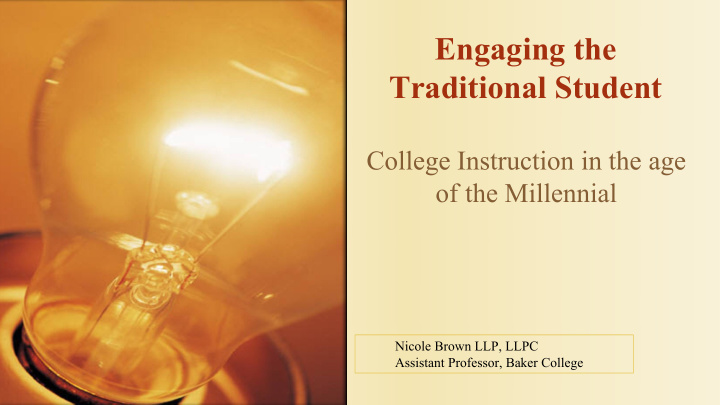



Engaging the Traditional Student College Instruction in the age of the Millennial Nicole Brown LLP, LLPC Assistant Professor, Baker College
Traditional Vs. Non-Traditional Students ● Non-Traditional ◦ Older ◦ Higher level of Maturity ◦ Work Experience ◦ Life Experience ● Traditional ◦ Fresh out of High School ◦ Inexperienced Emotionally ◦ Finding Personal Voice
The Milennial Student ● Development of the Traditional Student ◦ 12+ = Higher Level thinking including Abstract Conceptualization ◦ 17 = Fully Developed Personality ◦ 22-25 = Fully Developed Brain Function ◦ Life Experience = Emotional Regulation
Milennial Traditional Student ● Media Overload Media Overload ● Traditional Growth and •Social Media Inundation. •Constant Bombardment of information. progression ● Lack of Social Skills Traditional Growth •May not become Independent as soon. •May not engage in traditional ideas like marriage and gender. Social Skills •Limited Face to Face social Interaction. •Earn to interact through what they view. •Inability to recognize and regulate emotions.
Now What? ● The Traditional Student Has Changed ● To Reach the Traditional Student, Teaching must also change
Engaging the Traditional Student ● Powerpoint = Boring and loss of attention ● Lecture = Boring and loss of attention ◦ We must be active ◦ We must be innovative to engage ◦ We must be flexible
Active Engagement ● Be Active ◦ Walk Around the Room, A lot (No Podium or Computer Desk Hiding spots) ◦ Be sure to engage all your students, Ask Questions ◦ Consider how Kinesthetic activities will help to engage the Milennial ◦ Brainstorm ◦ Use your Dry Erase Board ◦ Go outside!! (They rarely seek outdoors)
Being Innovative ● Activities and Groups ● Find a way to make old information sound New and Exciting ● Relate the information to a student’s current experiences
Flexibility ● Take the pulse of Room ● Stay On/Off topic ● Allow space to connect more personally ● Manage Self-Disclosure - Too Much Vs. Too little
Manage Your Room ● Talkers vs. Non-Talkers ● Require your students to participate ● I WONDER!! Allow your students to answer other students questions ● All responses are good responses (Within Reason) – the act of participation should be reinforced
Realistic Goals and Expectations ● Establish Your Expectations Early – Day 1 ● Consistency - Maintain same expectations at every class ● Reinforce Behavior – Yes Psychology ● Adhere to your boundaries ● You do not have to know everything
What are We Really Teaching? CRITICAL THINKING
Critical Thinking Stages ● 6 Stages of Critical Thinking ◦ Unreflective ◦ Challenged ◦ Beginning ◦ Practicing ◦ Advanced ◦ Accomplished Foundation for Critical Thinking, (2017)
Critical Thinking Skills ● Identification ● Research ● Identifying Biases ● Inference ● Determining Relevance ● Curiosity Erstad, (2018)
Teaching Critical Thinking ● Questioning – Asking for input and thoughts ● Relating to Current Events ● Going off Topic ● What are you passionate about – Use to connect ● Play Devil’s Advocate
Your Thoughts on fostering and Developing Critical Thinking ● Active, Engaged Discussion
On Ground Vs. Distance Learning ● Ground Campus ● Distance Learning ● On-Line Classroom ● Discussion Questions ● Group Activities
Q & A Let’s chat
References Foundation for Critical Thinking (2017). Retrieved from www.criticalthinking.org W. Erstad (2018). 6 Critical thinking skills you need to master now. Retrieved from www.Rasmussen.edu
Recommend
More recommend